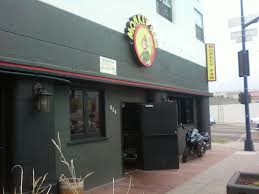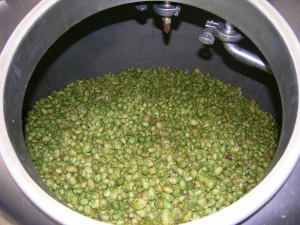 One of the highlights of my recent San Diego trip (read more about it here) was lunch at Monkey Paw Brewpub. This funky little place doesn’t look like much on the outside, but it serves up some of the more interesting and diverse range of beer around. As I mentioned before, they pride themselves on never making the same beer twice. They have a good handle on San Diego-style beer (read: drier and crisper and hoppy), but they also have a deft touch with other styles as well. The day I was there they had, among others, a fantastic Scotch Ale (McGavin’s Plaid Monkey), a shockingly dry and light double IPA (Gibbon Back) and a fascinating beer (Sweet Georgie Brown) that straddled the brown ale, porter and stout categories without seeming out of whack.
One of the highlights of my recent San Diego trip (read more about it here) was lunch at Monkey Paw Brewpub. This funky little place doesn’t look like much on the outside, but it serves up some of the more interesting and diverse range of beer around. As I mentioned before, they pride themselves on never making the same beer twice. They have a good handle on San Diego-style beer (read: drier and crisper and hoppy), but they also have a deft touch with other styles as well. The day I was there they had, among others, a fantastic Scotch Ale (McGavin’s Plaid Monkey), a shockingly dry and light double IPA (Gibbon Back) and a fascinating beer (Sweet Georgie Brown) that straddled the brown ale, porter and stout categories without seeming out of whack.
The beer (and the cheesesteaks) alone would have made it a pleasurable spot worth noting , but a couple of other elements made it really stand out.
First was the owner, Scot Blair (who also owns the renowned Hamilton’s Tavern). He was a fantastic host, and has a infectious passion for what he is doing. He and I talked beer for an hour and half (pity my lunch companion that day). He has a marvelous palate and the most impressive talent for describing what he is tasting. He and I picked up similar subtleties in the beer we sampled, but I found I always preferred the way he described it. Evocative with lots of rich detail, as the best descriptions are.
The second reason was that, by happenstance, they were brewing the day I dropped by. Their brewhouse is adjacent to the pub in a space smaller than most people’s garage. Current brewmaster, Cosimo Sorrentino, was just finishing up the boil when I arrived. As an aside, Monkey Paw also makes a conscious point of hiring homebrewers as their brewmasters. Not ex-homebrewers who made the jump before, but hiring active homebrewers for their first professional job. Blair tells me this has two purposes. First, it keeps the beer original, creative and playful as no one breaks brewing rules like homebrewers. Second, it is part of a strategy to grow the brewing talent base in the region. Blair sees his pub as a stepping stone for the brewers, a place to launch a professional career.
But back to my main point. The beer they were making that day happened to be a fresh hop beer. That morning they received a shipment of hops (thirty kilograms if my memory serves – I neglected to write the number down) that had been picked the afternoon before. Cool enough. It gets better, though.
They wanted to maximi ze the aroma and flavours from the fresh hops by utilizing them post-boil. But Monkey Paw does not have any kind of hopback or hop torpedo. So what to do? Well, put them in the mash tun, of course! They poured all the hops into the cleaned mash tun, which nearly filled the vessel (see photo) and then ran the wort back to the top of the mash tun, through the bed of hops, down the false bottom and into a fermenter to await the yeast.
ze the aroma and flavours from the fresh hops by utilizing them post-boil. But Monkey Paw does not have any kind of hopback or hop torpedo. So what to do? Well, put them in the mash tun, of course! They poured all the hops into the cleaned mash tun, which nearly filled the vessel (see photo) and then ran the wort back to the top of the mash tun, through the bed of hops, down the false bottom and into a fermenter to await the yeast.
All I can say is it is an ingenious and clever lo-tech solution to an issue. No need to buy more equipment, just re-purpose the stuff you already have.It wasn’t particularly elegant and had one or two potential safety hazards (hot wort, anyone?), but I can tell you while it was happening it was the best smelling brewery I have ever experienced. Plus I realized I can do EXACTLY the same thing at home, which is a pretty exciting prospect.
The only sad thing about the whole experience is that I will never actually get to try the finished beer. I can imagine the hop aromatics on it will be amazing, going from what I smelled in the brewery.

Leave a Reply